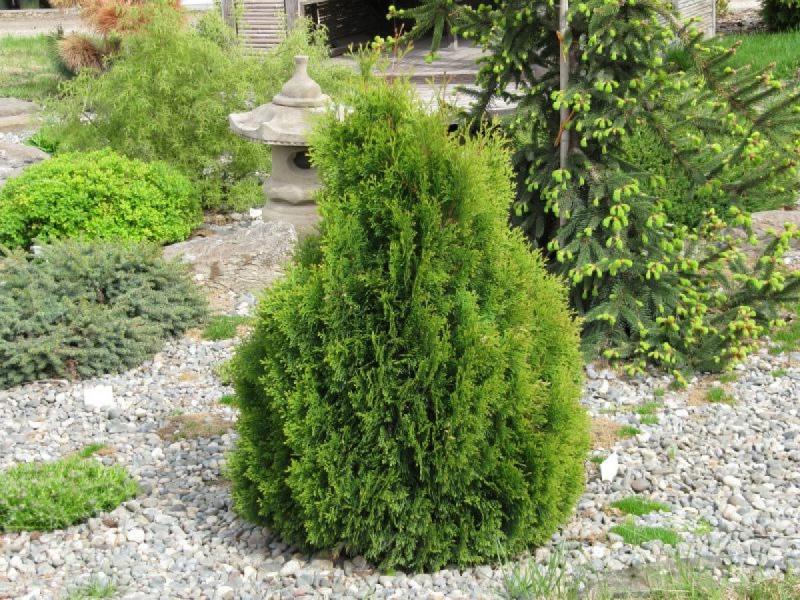 Thuja is a long-term plant that grows mainly in the southern countries - America and Asia. Despite its heat-loving "roots", this conifer has taken root quite well on Russian soil. Keeping it in the garden is a simple matter, because the thuja is a very unpretentious tree.
Thuja is a long-term plant that grows mainly in the southern countries - America and Asia. Despite its heat-loving "roots", this conifer has taken root quite well on Russian soil. Keeping it in the garden is a simple matter, because the thuja is a very unpretentious tree.
It can be grown directly in the open ground or kept in a pot - in any case, this cute evergreen plant will become a true decoration of a summer cottage.
Content
Plant species
One of the most popular conifers of our time has more than 120 different varieties, which differ in size, shape, color of needles. Most of them are created by crossing different types of arborvitae. We explain the breeders' interest in this culture - the demand for such unpretentious beauty is too great. Due to the purely decorative features, thuja is often used in landscape design. And for good reason, because it has a lot of advantages: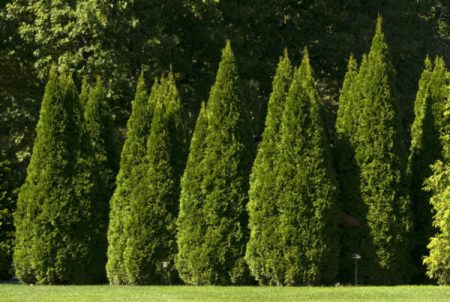
- the tree does not change the juicy green color in winter or summer;
- soft, with numerous leaves sprigs exude a dizzying aroma of essential oils;
- the plant requires a minimum of cost and effort to care, as it is very unpretentious;
- thuja has been pleasing to the eye for decades.
The most successful among domestic gardeners are the species of thuja “eastern” and “folded”.
Thuja orientalis (Thuja orientalis)
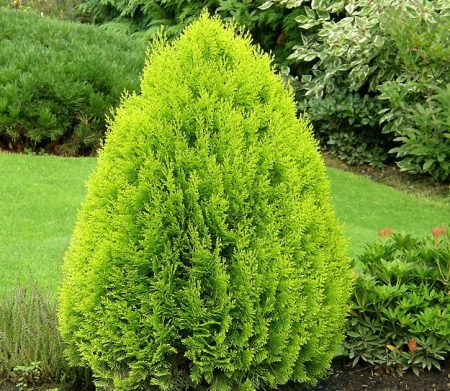 Oriental thuja is a coniferous plant, called in botany the Ploskovetnik Oriental (Platycladus orientalis) or Oriental Biota (Biota orientalis). It is widely found in Korea and China, grows in the wild in the steppes on poor soils. Such a thuja can grow for several hundred years, almost without changing its appearance. It develops very slowly, has the form of an ordinary tree, reaches 5-10 meters in height. In cold climates it takes the form of a bush. The crown is wide down and very narrow in the apical part. The needles are scaly, bright green. Young plants are prickly, similar to a Christmas tree. In winter, the eastern thuja changes the outfit to golden or brown.
Oriental thuja is a coniferous plant, called in botany the Ploskovetnik Oriental (Platycladus orientalis) or Oriental Biota (Biota orientalis). It is widely found in Korea and China, grows in the wild in the steppes on poor soils. Such a thuja can grow for several hundred years, almost without changing its appearance. It develops very slowly, has the form of an ordinary tree, reaches 5-10 meters in height. In cold climates it takes the form of a bush. The crown is wide down and very narrow in the apical part. The needles are scaly, bright green. Young plants are prickly, similar to a Christmas tree. In winter, the eastern thuja changes the outfit to golden or brown.
Popular varieties
| title | characteristic |
|
Aurea Nana
|
A dwarf variety that grows mainly in warm climates. Designers love to use this variety because of the dazzling green of the leaves, the conical shape of the crown, which over the years turns into an egg-shaped, and slow development. An adult plant grows to 1.5 meters tall. In winter, the needles change their color to yellow with shiny playful notes. Cold temperatures are detrimental to this thuja, so for the winter the plant should be carefully covered and the earth mulched. Aurea Nana is able to show all its beauty only on fertile, light and moist soils and in lighted areas. thuja
|
|
Justynka
|
Colon-shaped thuja of undersized type. The height of a mature plant reaches no more than 120 centimeters. The crown is dense and dense, practically does not require trimming. Justina winters well in the central regions, painlessly tolerates dry periods, never gets sick. Suitable for any type of landscaping.
|
| Morgan |
The pyramidal stately plant is the brainchild of Australian scientists. The branches have a golden color, which in the winter takes on a reddish-bronze hue.A low-growing variety, the height of the plant does not reach a meter. The growth is very small - 5 centimeters. Ideal for decorating borders and front gardens.
|
Thuja occidentalis (Thuja occidentalis)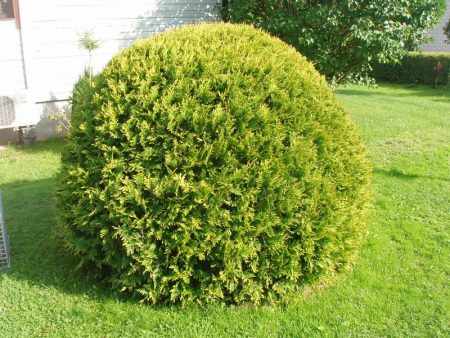
This variety is distinguished by the height of the tree - up to 20 meters. Western thuja is called due to its origin and habitat - North America. The crown of its strict pyramidal form becomes softer with age. Its reddish bark is hard, often cracked, hanging down the trunk. The foliage is dark green, soft. Cones up to 1.5 centimeters long ripen in the fall.
Popular grade
| title | characteristic |
| Emerald |
A strong, powerful 5-meter tree in appearance resembles cypress (thuja belongs to the cypress family). The color of the foliage is emerald. It does not change all year round. The variety is very unpretentious, frost-resistant, with strong immunity. It grows successfully on any type of soil. The only condition for care is protection from direct sunlight. But it cannot grow in the shade. The variety is very long-growing; shoots grow by only 10 centimeters per year. Ideal for decorating hedges.
|
| Golden Smaragd |
Variety variety Smaragd. It differs in the golden color of the branches. The maximum height of the tree is about two meters. The crown is predominantly conical, dense, dense. A plant develops well in nutritious, drained, moist soil. Bad ecology affects development - it slows down, appearance becomes sick. The variety is great for cottage decor. It can grow in any climate. Very hardy.
|
|
Danica
|
A variety of Danish breeding bred in 1948. Spherical undersized shrub with juicy green wavy foliage and soft fan-shaped branches that exude a delicate aroma of needles. In winter, the greens become brown. Plant height does not exceed one meter. The increase is not more than five centimeters per year. The optimal variety for arranging rockeries, growing along borders.
|
| Aurea Danica |
The underprot of Danica Aurea is distinguished by a more yellowish tint of branches and leaves. Aurea’s care is also unpretentious, although, like everyone loves fertile soil, frequent irrigation by sprinkling. Due to weak growth, pruning is not necessary. Crohn plastic, suitable for the formation of any shape. The roots of the plant are superficial, and therefore, in order to protect, the trunk circle should be mulched, loosening is shallow. It requires shelter for the winter.
|
| Brabant |
Tall variety with fast growth, plant height can reach 15 meters. Annual growth is 30-40 centimeters. Moreover, the plant grows not only upward, but also in breadth. The width of the crown grows by 15 centimeters per season. Brabant foliage bright green with golden ends does not change color all year round. Unpretentious, drought tolerant, hardy variety. Recently introduced a new variety of this variety - Brabant-Golden. The subspecies is distinguished by a lighter shade of foliage.
|
|
Fastigiata
|
German grade. A tall plant (up to 15 meters tall) has the ability to quickly develop, build up shoots. The crown-shaped crown is greatly narrowed at the top, endowed with erect branches, which seem to rush into the sky. An unpretentious plant with a minimum of needs and a maximum of decorativeness. It responds well to a haircut. Propagated through seeds, but the offspring may differ in genetic code. |
Thuja folded (Thuja plicata)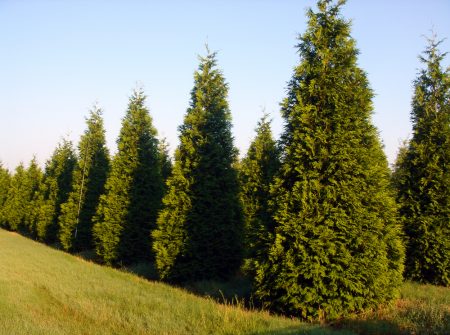
In the wild, these thujas are inconceivable in size - more than 50 meters. In our area, folded arborvitae are not so tall. Their height often reaches 12-15 meters - no more. Plants of this group do not differ in frost resistance, often part of the frozen crown has to be cut. The crown of trees is low, it is dense, very spreading. Needles of emerald color with overflows.
This variety of thuja includes about 50 different varieties.All of them are used in parks (due to overgrowth and rapid growth).
Popular varieties
| title | characteristic |
|
Whipcord
|
A variety of remarkable appearance: the dwarf plant has a spherical shape with long green drooping branches. It looks like emerald rain is pouring. Barrel height not more than 1.5 meters. In winter, the needles change color to bronze. The annual growth is small - 7-10 centimeters. It grows well on moist soil with sufficient nutrients. Cultivation of the variety is mostly local, since alone a magnificent ball looks the most spectacular.
|
|
Zebrina
|
The sparse crown of a tall tree resembles from a distance an ordinary spruce. The plant can grow on any type of soil, but in poor soil it develops twice as slow. Lateral shoots grow in drooping condition, skeletal branches are wide-spread, with scaly light green crown. Suitable for single landing.
|
Thuja Japanese or Standisha (Thuja standishii)
It grows in the vastness of Japan. Moisturizing plant, loving the plentiful sun and fertile soil. It does not tolerate severe frosts well, but it reacts negatively to drought. It grows mostly single on well-lit places.
Japanese thuja is a tall tree in the shape of a pyramid. It has a wide base and a narrow apical part. The bark is burgundy in color, it is friable, it exfoliates strongly with age. Needles matte green with a whitish tint. The height of the wild tree is more than 20 meters. Cultivated variety has a modest size - only 6-9 meters.
Thuja korean (Thuja koraiensis)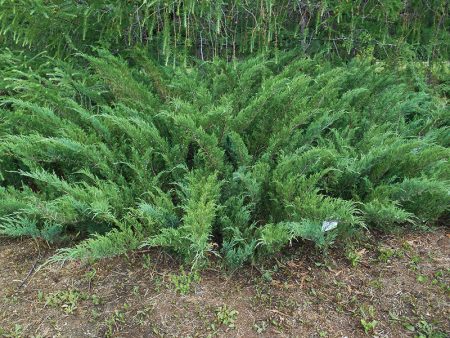
7-8-meter tree or shrub plant with a conical crown. As is clear, it grows on Korean soil. It is considered a winter-hardy species of thuja. Needles of a light shade. Numerous branches are soft, grow obliquely from the trunk. The bark is reddish, rough. Thanks to the long side shoots, a voluminous appearance is created that gives the plant a bit of chaos, as thin branches sometimes overlap and “mix”. Korean thuja grows on mountain slopes and in coniferous forests.
Thuja care after landing
One-year-old arborvitae can be planted in spring or autumn. After planting, thuja seedlings need time to take root in a new place and grow. For the successful development of all conditions are created: systematic irrigation is arranged, the soil is cultivated, fertilizing is applied.
Speaking of top dressing: the first year of life of the thuja can grow without additional fertilizers. It is enough for her that was brought into the soil when the plot was backed up. After planting, you can only stimulate the healthy development of the plant, for example, add the stimulator "Epin" or apply Zircon solution. These drugs help protect young plantings from pests and diseases and help better digestibility of nutrition from the soil.
It is important to saturate the roots of the tree with moisture. Although thuja loves water, it does not tolerate stagnation of water, so it is planted in areas with low groundwater, but meanwhile it is watered infrequently and abundantly. Lack of moisture immediately affects the appearance of the plant - the apical part begins to turn yellow and fade. With regular watering, this problem can be avoided. The first month after planting, plants need more moisture than ever. The conifers are watered every 6-7 days in moderate weather and 2 times a week in drought, while spending 2-3 buckets on each plant. In wet summer, thuja do not water - they have enough natural rainfall.When watering thaw, you need to use the sprinkling method - so the juiciness and freshness of the leaves will be even stronger, the coniferous aroma will become brighter, and the branches will clear of dust and shine. Water the crop in the early morning or late afternoon.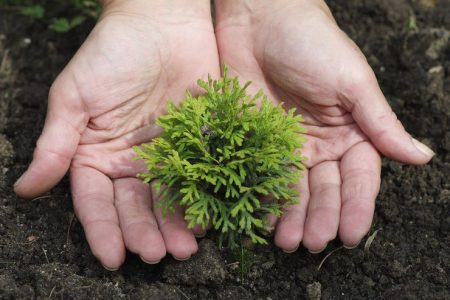
The basal area should be kept clean from weed grass. To cope with the ubiquitous weed, loosening will cope, which also contributes to good soil aeration. To deter moisture evaporation, experts recommend mulching the plantings. Either sawdust or compost are suitable as mulch. Such a shelter prevents the weed from growing, and overripe, also nourishes the soil with nutritious juices. The roots under the mulch are reliably protected from the scorching summer sun. As a result, the tree feels better and turns green every day.
The first two years, the thuja is eyeing a new place of residence, taking root. With a haircut at this time, you should wait until the tree reaches the desired size and grows with a sufficient green cap.
Subsequently, the weekly work on the care of the crop will be supplemented by sanitary and formative pruning. Initially, it is necessary to remove all broken, old and damaged branches - this is done in April. Then the bush is thinned, removing unnecessary shoots from the plant, as well as annual growths. A shaping haircut is produced depending on the variety. Almost any figure can be formed from a thuja, and it will become the main element of the garden design.
Autumn Care and Wintering
With the advent of autumn, the thuja begins to prepare for rest. Care at this time is not as intense as in spring and summer, and has its own tasks. By the end of summer, they cease to feed thuja in order to stop its growth. Before frost, the plant should slow down its life cycle and go into hibernation. This is the only way to protect her from death.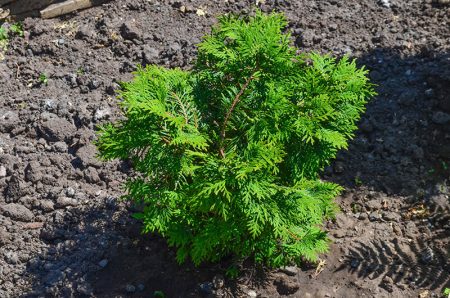
In the autumn, garden plants begin to be abundantly watered, as the thuja sleeps in the winter, but still it develops and it needs moisture. The last cultivation is also carried out in the fall in order to saturate the earth with oxygen. Only then the site is mulched with sawdust, peat or wood bark.
Many people prefer to transplant thuja in the fall. This decision is somewhat reckless, since the plant may not have time to take root before winter, however, if you still undertook such a responsible task, then according to the recommendations of specialists, you need to do this before the onset of constant cold weather, namely in September. The transplant is performed by transshipment, preserving the main part of the earthen coma on the roots - so the plant will quickly take a new place.
The main mission of autumn care is to protect plants from impending frosts. Thuja is a plant of warm climate. Our winter, most species of thuja can not stand. Therefore, the plant needs to be prepared for the cold period in order to minimize the risk of freezing of branches or more significant losses. While the temperature does not drop too low, it is enough to cover the base of the tree with spruce branches.
For winter, seedlings up to three years old (and all heat-loving species) require shelter. For this purpose, any non-woven material is suitable. But it is important that it allows air and light to pass through and not interfere with photosynthesis. You can use burlap, but it will not cover the entire area of the plant. Usually, spanbond is used for shelter or a wooden frame is built and covered with material. To facilitate the task, the branches of a young thuja are pulled together with a rope, pressing it to the trunk. Then only the plant is wrapped with covering material. The roots are protected with a thick layer (at least 10 centimeters) of mulch from sawdust, bark, peat, compost or old grass.
Before sheltering, yellowed and dried branches, as well as those affected by the disease and broken, are cut out from the plant.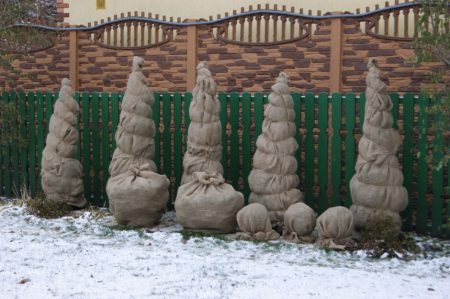
With the advent of heat, thuja is opened. You need to do this as soon as there is practically no snow, and the air warms up to 15 degrees. It is important not to be late with cleaning the shelter, otherwise condensation will begin to form inside, which will cause the development of the fungus. Do not rush either - the wood can get sun-frost burns.
As soon as the soil under the trees opens, produce a water-charging irrigation. Water should penetrate to a depth of up to 50 centimeters, so you need to pour generously. Moisture will quickly awaken the roots, and the plant will begin to grow faster.
Spring care
In the spring, active care for the arborvitae begins, which includes several fundamental points. One of them is protection against spring burns.
Spring burn protection
With the establishment of warm weather, the seedlings are cleared of snow if it has hibernated barefoot or the frame is removed. It would seem that the most dangerous time for a tender thermophilic plant - winter - has passed. However, good spring days are fraught with many dangers for culture. The first thing that can seriously harm the trees is the active sun. As already mentioned, aggressive ultraviolet light at this time can affect young bark. As a result, green twigs suddenly become pale, yellow, and severe burns can cause a partial loss of needles. This can be avoided with the help of a special covering light material that covers plantings on clear days.
Pruning
After removing the material, as soon as all the branches straighten out, they will return to their original position, begin to trim and form a bush. First, they carry out a sanitary haircut - they remove all unnecessary branches (broken, dried, with signs of illness). Then proceed to trim the shape of the crown. Haircuts are carried out using a special secateurs, which can be removed "split ends" to give the necessary shape. The location of the trees should be taken into account: if they grow in the shade, then during spring pruning you need to pinch the top, and do not touch the side shoots. The fact is that the upper shoots in search of the sun are strongly pulled up and they need to be a little restrained. And to give splendor to the plantings (for example, when creating a decorative fence), in spring you can pinch all the young shoots by 2-3 centimeters.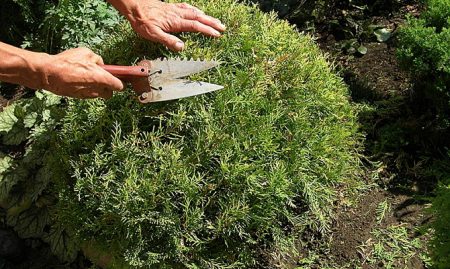
The center of the crown should allow air to pass through well. In this case, it is necessary to thin out thickened places regularly, otherwise a fungal infection will develop in them and insects will multiply. By the way, birds like to settle in the crown of fluffy branches, propagating their offspring there.
Top dressing
Feeding up after a long winter will help thuy. Spring application of fertilizers very quickly restores the nutritional balance and saturates the roots of plants very quickly, since there is still a lot of moisture in the ground, which means that the circulation is not slowed down. Mineral and organic compounds as well as complex fertilizers containing a whole set of necessary elements are suitable as top dressings. But it is better to use specialized preparations for conifers. For example, Zircon will increase the absorption of substances and protect against viral diseases, and the equally popular Biud will charge plants with important trace elements. Good effect on the culture drug delayed action "Fertika". It supplies the soil with micronutrients for several months, so if you add it in the spring, then in the summer you can forget about additional fertilizing. Of natural fertilizers, compost is most often used.
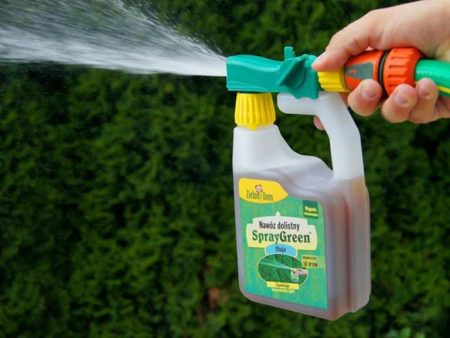
In general, thuja does not need an abundance of fertilizing - it can grow quite fully without them, but only on condition that the soil on the site is quite fertile. Fertilizers must be applied carefully, in small doses - a high concentration can harm the roots.
Pest treatment
Do not forget in the spring and about the preventive treatment of trees from harmful animals and various diseases. Plants are sprayed with complex preparations - fungicides and insecticides that protect plantings from pathogens. Most often used for these purposes are “Fundazol”, “Rogor”, “Karbofos” (against fungal diseases and false insects) and “Cypermethrin” (from aphids and mosquitoes).
High resistance of thujas to diseases is noted. Fungi and viruses do not infect trees often, but if signs of the disease appear, then it is not so difficult to cure them.
It should be noted that coniferous diseases are treated quite successfully. The main thing is to detect them at the initial stage of development and tackle the problem closely. Spring is the right time for this.
Additional treatments
Spring is the perfect time for transplanting thuja. In general, it is preferable not to change the place of growth at all, but this procedure is sometimes necessary. For example, if the seedling was originally planted incorrectly (the root neck was deep underground), then it naturally will not be able to develop normally and will quickly wither and die. With the advent of heat and warming up the soil, the plant is transplanted again or raised and strengthened at the optimal level.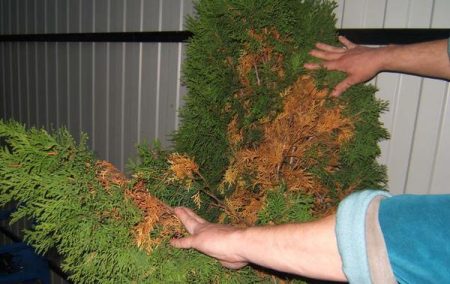
In spring, plantings are well shed with water to awaken the root system. On fine days, it is enough to arrange 1 watering per week. In too dry periods - 2-3 times a week. Transplanted trees require more water for better survival. After winter, soil density becomes too high. Heavy soil does not pass water well, and it begins to accumulate around the trunk, causing it to rot. Loosening, which is carried out immediately after the snow melts, helps to avoid this. Manipulation is carried out carefully, since the root system of the thuja is not deep.
Potted thuja care
You can grow one at home, however, caring for the plant in the pot is slightly different from the usual way of cultivating the crop. For successful growth, it is important to create the correct temperature regime, especially in winter. The optimum temperature for it is no higher than 12 degrees in winter and 18-20 degrees in summer. In a too warm room, where the air is overdried, the thuja dries quickly, turns yellow. Therefore, before starting such a homely “flower”, it is better to immediately determine whether it will be possible to please the thuja with temperature? Usually the bushes are kept in the winter on the balcony or porch, but they must be glazed so that the plant does not freeze.
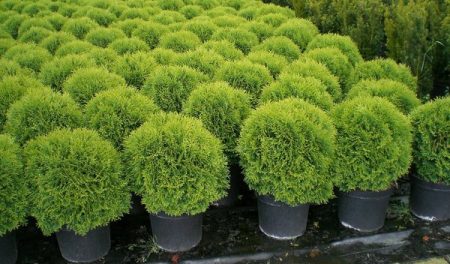 Another important parameter for healthy plant growth is proper lighting and location. The sun should fall on thawing constantly, but not in direct sunlight, but in diffused light, otherwise the leaves will “burn out” and begin to fall off. The shrubbery is next to the window on the north side of the house, but it should be curtained with tulle. In the shade, the plant is very elongated, becoming ugly and faded. You can’t put a pot near heat sources - it is very likely that plants will dry out.
Another important parameter for healthy plant growth is proper lighting and location. The sun should fall on thawing constantly, but not in direct sunlight, but in diffused light, otherwise the leaves will “burn out” and begin to fall off. The shrubbery is next to the window on the north side of the house, but it should be curtained with tulle. In the shade, the plant is very elongated, becoming ugly and faded. You can’t put a pot near heat sources - it is very likely that plants will dry out.
For potted arborvitae, constantly moistened soil is important.Over-dried land will not allow the shrub to fully develop, and it simply stops growing. For a home plant, it is important to arrange regular watering 2 times a week. If the air is too dry, then the crown must be sprayed so that the leaves are green and juicy.
Thuja grows well in loose and nutritious soil mixtures of leafy earth and coarse sand, and for an adult tree sod, peat and sand are mixed. Top dressing is infrequent, alternating with mineral compositions. In the spring, you can feed soil once with nitrous agents, and in the summer, add potassium-phosphorus compounds. Indoor thuja is almost never affected by disease. It is well protected from attack by pests. However, this is not a reason to let the needles' health drift. Shoots and leaflets must be regularly examined and in case of ailment detection, it is imperative to cut out sore spots and treat with fungicide. To save her, if the disease has just manifested, you can quickly and without unnecessary losses.
Growing thuja in a pot determines the need for an annual transplant. Since the root system of the plant is growing rapidly, a high, but not too wide pot is selected for the culture, the bottom of which should contain a drainage layer to drain excess moisture. Adult thuja are transplanted every two to three years.
Potted thuja is primarily decorative. Due to its flexible and ductile crown, the shrub can “take” any shape with skillful pruning. Usually the oriental thuja has a pyramidal shape, but from it you can make a ball, cone or spiral - all at the discretion of the owner.
Thuja, however, like any other plant, requires care. When caring for her, you should not neglect dressing, watering and protection for the winter from freezing. Creating comfortable conditions for growth, thuja with its beauty will delight its owner for decades.




 Sow in the ground, without seedlings: 10 beautiful and unpretentious flowers
Sow in the ground, without seedlings: 10 beautiful and unpretentious flowers Platicodon planting and outdoor care
Platicodon planting and outdoor care Hosta - planting and care in the open ground in the Urals
Hosta - planting and care in the open ground in the Urals Oleander - care and growing at home
Oleander - care and growing at home